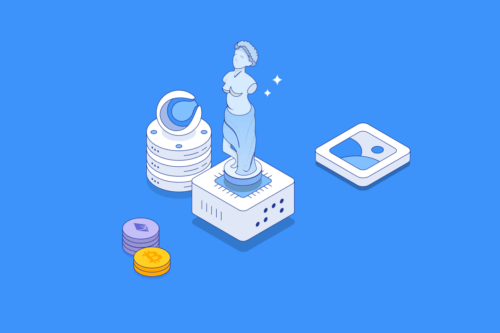
Many in society believe cryptocurrency is just a digital currency with no real use other than being a medium of exchange. The blockchain is still largely misunderstood and often thought of as solely existing to support the crypto trade. The industry’s scope has expanded since Bitcoin’s inception in 2009. Blockchain technology has a variety of applications that may have the power to revolutionise modern businesses in finance, supply chain management, security, and so much more. This article will explore the goals of crypto and the blockchain while diving into specific problems developers try to resolve.
What is a blockchain?
A blockchain network is a form of distributed ledger technology. Think of the blockchain as a database of information – but instead of existing on a single server, the data is spread across thousands of different computers, each running a copy of the blockchain. Every transaction made on a network is listed and time-stamped, and due to the cryptographic nature of the blockchain, these records are almost impossible to alter.
Tip
Transactions recorded on the blockchain can portray more than just the exchange of money. People can use cryptocurrency to represent ownership of nearly anything – physical objects like concert tickets, houses or cash, and intangible objects like digital artwork, IP addresses or game items.
Why was cryptocurrency invented?
Bitcoin was created in 2009, partially in response to the previous year’s Global Financial Crisis (GFC). Through this period of instability, societal trust in banks and other centralised financial agencies was dwindling, and Bitcoin sought to invent a currency free from the control of the government and financial institutions.
Additionally, nearly 2 billion humans worldwide are unbanked – meaning they lack access to basic financial services and can’t make online transactions. Bitcoin intended to resolve this and provide a way to make online payments, internationally and locally, without needing a bank account.
Cryptocurrency was initially conceptualised as a medium of exchange. However, investors have turned to certain currencies like Bitcoin as a store of value rather than a payment method. In that sense, Bitcoin’s trajectory can be viewed as similar to gold’s which once was primarily used as a medium of exchange but now is primarily seen as a store of value – but completely digital.
Areas that cryptocurrency is tackling
Cross-border payments
Even in modern times, sending money overseas can be problematic. Foreign exchange fees are often quite hefty while settling transactions can take days. In addition, cross-border Even in modern times, sending money overseas can be problematic. Foreign exchange fees are often quite hefty while settling transactions can take days. In addition, cross-border payments are only accessible to those using a bank that supports them.
For example, many people work overseas to support their families and have to send their income back across borders. When forex fees are paired with international transfer fees (often more than $30 per transaction), they could add up very quickly.
Although transaction fees vary based on the blockchain being used, desired speed of transfer, and network traffic, sending crypto overseas won’t cost any more than sending it to a next-door neighbour. Crypto also does away with the necessity of a third-party payment provider, like SWIFT or PayPal, which further eliminates fees.
Several projects, such as Ripple (XRP), are specifically designed to provide lightning-fast, cross-currency transactions. These cryptocurrencies can settle international payments within seconds and at a meagre cost.
Counterfeiting
Counterfeiting is a problem as old as modern human society. Governments and banks have been trying to prevent national currencies from being replicated since their invention hundreds of years ago.
Cryptocurrency is, by design, almost impossible to counterfeit. Thanks to how the blockchain stores data, every single coin on a network can be verified and its transaction history reviewed. Therefore, if someone tried to spend a Bitcoin imitation, the blockchain would see it isn’t real and reject the payment before it finalises.
Did You Know?
Counterfeiting is an incredibly serious, albeit illegal, business. Some top-of-the-line counterfeits can sell for over 20% of the money’s face value – so $100,000 in fake money might cost more than $20,000. In 2021 alone, the Reserve Bank of Australia reported coming across more than $1.3 million AUD of counterfeit bills.
Inflation
Cryptocurrency has been described as a hedge against inflation. However, whether cryptocurrency is an effective hedge or is just as susceptible to inflation as other currencies and asset classes, remains hotly debated.
Regardless, over time, inflation causes fiat currency to devalue relative to goods and services. Inflation can occur for all sorts of reasons – governments releasing new supplies of cash, increasing demand for production and wage rises being some of the most common. Over time, inflation is why a $1 coffee twenty years ago might cost $5 today.
On the other hand, many cryptocurrencies have a finite supply. For example, there can only ever be 21 million Bitcoins in circulation. So long as demand remains intact, Bitcoin is unlikely to experience inflation in the same way a fiat currency might.
Third-party services
Cryptocurrency is a direct, peer-to-peer payment method that doesn’t rely on a central authority like a bank or government. This means that third parties aren’t necessary to conduct transactions unless an intermediary such as an exchange is involved. For example, sending money via a bank transfer or PayPal requires those companies to control your assets, at least temporarily. However, crypto transactions are self-governed, which mitigates fees from payment processing companies, minimises security breaches, and ensures your money never leaves your control.
Blockchain applications
The blockchain is a database that facilitates cryptocurrency transactions – without it, digital currencies would not work. However, the scope of this technology is grander than just a database, and the blockchain is already being explored by major industries as a potential game-changer.
Smart contracts
Smart contracts, also known as “programs”, are lines of code that automatically execute upon meeting certain conditions. This automation allows transactions (or other agreements) to be finalised immediately without needing an intermediary.

The use of smart contracts in businesses is yet to be fully realised. Still, blockchain users are already seeing the power of this technology. Smart contracts form the backbone of the decentralised finance industry – without them, earning opportunities like liquidity mining and staking wouldn’t exist. Similarly, the advent and growing popularity of NFTs is only possible due to smart contracts.
Key Takeaway
Smart contracts may become a core piece of technology in various financial industries. Take a loan broker for instance. The broker could use smart contracts to automate a repayment schedule, removing the potential for human error in accounting. Then, when the loan is paid off, the smart contract could automatically transfer ownership of an asset – represented by a crypto token – to the borrower. This would save time and costs for both the broker and the borrower.
Supply chain management
The Covid-19 pandemic threw a spanner in the works of global supply chains, which created a need for efficient and autonomous systems. The supply chain industry occasionally suffers from poor quality assurance, difficulty tracking items and fraudulent behaviour from suppliers and distributors.
Blockchain technology could prove invaluable to the supply chain industry. Blockchain data can’t be modified, allowing it to maintain data integrity, and the facilitation of smart contracts allows for autonomous global asset tracking.
Avoiding fraudulent activity while tracking items across the globe could become more manageable. Additionally, the blockchain’s speed and data transparency would help automate the industry further, potentially saving businesses millions.
The list of companies using the blockchain to aid their logistics process and asset management is expanding. Walmart, Ford, FedEx and Microsoft have all implemented or trialled blockchain technology in their operations.

Patient health and medical history
Protecting the privacy of an individual’s medical records is of paramount importance, no matter whether you’re a doctor or a patient. At the same time, seamlessly accessing an accurate medical history is crucial to ensuring doctors can make correct diagnoses and prescribe the right medication.
The decentralized nature of the blockchain ensures that no one entity can control or manipulate a patient’s medical history. Because it is trustless, hospitals and medical clinics can share and find vital medical data without relying on each other to pass on accurate information. There already exists a handful of blockchain-based medical companies that handle personal medical records and medical supply chain management.
NFTs and DAOs
Decentralized Autonomous Organisations (DAOs) are a new way for businesses to set up governance using smart contracts. Essentially, it removes the need for a centralized body (such as a CEO or manager) to execute decisions. This way, all stakeholders can have a fair, democratic say in how a business is run, rather than leaving decision-making to an individual who may have ulterior motives.

NFTs are another blockchain invention. They are digital tokens used to represent ownership of digital assets – fine art, music and cars, for example. A potential benefit of NFTs is opening revenue streams to content creators and artists who would otherwise receive minimal income. NFTs could help level the playing field between mega-famous artists and those with only a few dedicated fans. People can pay what they want for ownership of an asset, rather than paying a pre-determined royalty set by companies like Spotify or YouTube.
Admittedly, most successful NFT content creators were already famous before the NFT explosion. However, the new technology has created a potential platform for digital artists to gain exposure and build their fanbase.

Tokenising assets
Tokenised assets, similar to NFTs, are digital representations of ownership. Tokenising assets has the potential to change the way investors trade alternative assets. For example, PaxGold is a platform that offers users to purchase tokens that mirrors the price of gold. PaxGold owners also owns the underlying gold. Each PaxGold token is equivalent to one fine troy ounce (t oz) of a gold bar, which investors can trade in for real bullion.

However, it is important to note that most tokenised assets give you no claim to the underlying asset, nor allow you to exchange a token for a share in that company. Instead, the purchaser is buying a crypto asset that attempts to mimic that of the stock, which may not be subject to the same level of regulation that a traditional share is. Time will tell if interchangeable, officially issued and regulated tokenised shares become the way of the future.
Another potential use case concerns traditionally low-liquidity, high-value assets that can often take months, if not years, to sell. Through tokenisation, assets can instead be fractionalised and sold on secondary markets. This not only improves the seller’s experience but gives members of society access to investment opportunities that would otherwise be non-existent.
Did You Know?
The Beatles Love Me Do EP is one of the most famous records ever released. A vinyl of the album, signed by all four members, was recently listed on Rally’s fractional investment platform. The asset is valued at $24,000, which may be a hefty price tag for the average investor. Thanks to NFTs, Rally has instead split ownership of the album into 6000 different tokens, each worth $4. So, if Rally sold the record for $100,000, one NFT share would be worth $16.66.
Disadvantages of cryptocurrency
While cryptocurrency and blockchain technology advancement unlocks an exciting new era for businesses, it’s not without problems. There are still several issues for the industry to resolve before it can see widespread adoption. The first and most obvious drawback of cryptocurrency is that the technology is still relatively new. Government regulation, smart contract bugs and hacking are all growing pains the blockchain will have to overcome.
Much has been made of the blockchain sector’s negative environmental impact. The majority of this criticism has been directed toward Bitcoin due to how much electricity mining BTC requires. Other blockchains are addressing this by transitioning to or launching on Proof-of-Stake, a much more sustainable way of validating transactions.
Because cryptocurrency is privacy-focused and government regulation has not, in part, caught up with the technology, it is often the currency of choice for transferring illegal goods and money laundering operations. While media attention on this particular blockchain use case may be somewhat overblown, it is still a major issue for crypto going forward.
Summary
Blockchain and cryptocurrency are more than just a store of value or an asset to be speculated on. The technology has real-world applications that may alter how society stores data and use money forever. Multiple businesses are already using blockchain-as-a-service (BaaS) solutions, particularly in the supply chain sector. This trend may continue to grow as more industries attempt to unlock the blockchain’s potential.
Whether the industry can ever reach this point is still up in the air. Developers will need to address cryptocurrency issues to gain mass adoption. Either way, it’s exciting to watch the blockchain ecosystem evolve and see just how far it can go.
Disclaimer: The information on Swyftx Learn is for general educational purposes only and should not be taken as investment advice, personal recommendation, or an offer of, or solicitation to, buy or sell any assets. It has been prepared without regard to any particular investment objectives or financial situation and does not purport to cover any legal or regulatory requirements. Customers are encouraged to do their own independent research and seek professional advice. Swyftx makes no representation and assumes no liability as to the accuracy or completeness of the content. Any references to past performance are not, and should not be taken as a reliable indicator of future results. Make sure you understand the risks involved in trading before committing any capital. Never risk more than you are prepared to lose. Consider our Terms of Use and Risk Disclosure Statement for more details.

